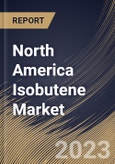The isobutene market refers to the market for the chemical compound isobutene, also known as isobutylene. Isobutene is a hydrocarbon with the molecular formula C4H8. It is an important industrial chemical used in various applications, primarily in producing petrochemicals and fuels. Isobutene is primarily produced as a byproduct of the steam-cracking process in the petrochemical industry. It is also obtained through the dehydrogenation of isobutane. Isobutene can also be produced from biomass through various techniques, which is gaining attention due to the increasing interest in sustainable and renewable sources of chemicals.
Isobutene is used to produce various haloalkanes, which have applications in chemical synthesis and organic chemistry reactions. Isobutene-based plasticizers are used to increase the flexibility and durability of plastics in applications such as wire and cable insulation and automotive interiors. Isobutene-derived products can be used in the production of oilfield chemicals, including demulsifiers and corrosion inhibitors used in the oil and gas industry. The overall demand for petrochemical products and synthetic rubber influences the isobutene market. In particular, the automotive industry's growth drives demand for butyl rubber. There is a growing interest in producing isobutene from renewable sources, such as biomass, as a more sustainable alternative to traditional petrochemical-based isobutene. Environmental regulations and sustainability goals are impacting the isobutene market as there is a push for more eco-friendly production methods and applications.
According to Select USA, the United States exported 1.4 million new light vehicles and 108,754 medium and heavy trucks (with a combined value of over $52 billion) to more than 200 nations worldwide in 2020, in addition to $66.7 billion worth of automotive parts. Overall, the United States is the world's second-largest vehicle sales and production industry. With the rising demand from the US automotive industry, isobutene producers and related industries may invest in expanding production capacity and technological advancements, ensuring a stable and reliable supply of isobutene-derived products. As the automotive sector continues to evolve, isobutene will remain crucial in meeting the industry's needs for high-performance tires and fuel additives.
According to the International Trade Administration, Canada exported an estimated 56.6% of goods from the aircraft, engine, and parts manufacturing industry to the US in 2021. The aerospace industry relies on advanced materials and composites for aircraft construction. Isobutene-based elastomers and polymers, like isobutylene-isoprene rubber (IIR), are used in seals, gaskets, and insulation, essential aircraft components. As a result, the growing aerospace industry in Canada expands the demand for isobutene-based products. The aspects mentioned above will boost market growth in this region.
The US market dominated the North America Isobutene Market, By Country in 2022, and would continue to be a dominant market till 2030; thereby, achieving a market value of $10,087.5 Million by 2030. The Canada market is exhibiting a CAGR of 6.3% during (2023 - 2030). Additionally, The Mexico market would experience a CAGR of 5.4% during (2023 - 2030).
Based on Product, the market is segmented into Methyl tert-butyl ether (MTBE), and Ethyl tert-butyl ether (ETBE). Based on Application, the market is segmented into Automotive, Aerospace, Pharmaceuticals, Antioxidants, and Others. Based on countries, the market is segmented into U.S., Mexico, Canada, and Rest of North America.
The market research report covers the analysis of key stake holders of the market. Key companies profiled in the report include BASF SE, Evonik Industries AG (RAG-Stiftung), Exxon Mobil Corporation, Sumitomo Chemical Co., Ltd., Global Bioenergies, Weifang Binhai Petro-Chem Co., Ltd (Tiande Chemical Holdings Co., LTD), Honeywell International, Inc., LyondellBasell Industries Holdings B.V., Linde PLC, and China Petrochemical Corporation (Sinopec Group).
Scope of the Study
Market Segments Covered in the Report:
By Product (Volume, Kilo Tonnes, USD Million, 2019-2030)- Methyl tert-butyl ether (MTBE)
- Ethyl tert-butyl ether (ETBE)
- Automotive
- Aerospace
- Pharmaceuticals
- Antioxidants
- Others
- US
- Canada
- Mexico
- Rest of North America
Key Market Players
List of Companies Profiled in the Report:
- BASF SE
- Evonik Industries AG (RAG-Stiftung)
- Exxon Mobil Corporation
- Sumitomo Chemical Co., Ltd.
- Global Bioenergies
- Weifang Binhai Petro-Chem Co., Ltd (Tiande Chemical Holdings Co., LTD)
- Honeywell International, Inc.
- LyondellBasell Industries Holdings B.V.
- Linde PLC
- China Petrochemical Corporation (Sinopec Group)
Unique Offerings
- Exhaustive coverage
- The highest number of Market tables and figures
- Subscription-based model available
- Guaranteed best price
- Assured post sales research support with 10% customization free
Table of Contents
Companies Mentioned
- BASF SE
- Evonik Industries AG (RAG-Stiftung)
- Exxon Mobil Corporation
- Sumitomo Chemical Co., Ltd.
- Global Bioenergies
- Weifang Binhai Petro-Chem Co., Ltd (Tiande Chemical Holdings Co., LTD)
- Honeywell International, Inc.
- LyondellBasell Industries Holdings B.V.
- Linde PLC
- China Petrochemical Corporation (Sinopec Group)








